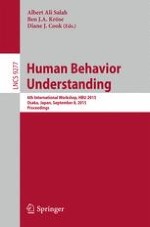2015 | Book
Human Behavior Understanding
6th International Workshop, HBU 2015, Osaka, Japan, September 8, 2015, Proceedings
Editors: Albert Ali Salah, Ben J.A. Kröse, Diane J. Cook
Publisher: Springer International Publishing
Book Series : Lecture Notes in Computer Science
